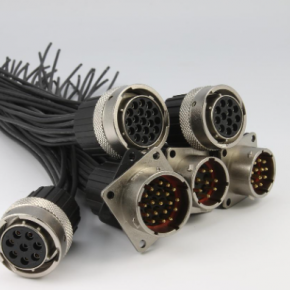
Inline Connectors 101: Choosing the Right Type for Your Electrical Needs
In electrical systems, inline connectors are an essential part. They make it easy, safe, and efficient to create connections and are quite useful in homes, automobiles, industrial machinery, and outdoor connections.
If you are working with any of these and need to use RS inline connectors for whatever reason, it’s important to have a clear idea of how they work and how to choose one. This article breaks down the most important factors you should consider.
What are Inline Connectors?
Inline connectors are electrical components that join two or more (often three) wires in a straight line configuration. Their main purpose is simple – to ensure a continuous and secure flow of electricity.
Unlike most other types of connectors, such as junction boxes or terminal blocks, inline connectors don’t need additional mounting hardware, their job is just to make a continuous connection. While doing this, they are also expected to make the connection secure and protect it against environmental factors like moisture, vibration, and mechanical stress.
Some inline connectors are designed to offer permanent connections, but most of those used in home and outdoor connections make it easy to connect and disconnect appliances.
Factors to Consider When Choosing Inline Connectors
Selecting the right inline connector is crucial as you need to ensure that all your connections are safe, efficient, and long-lasting. This means you’ll need to select the right one depending on the type of connection and various other factors.
Number of Pins (2-Pin vs. 3-Pin Connectors)
The most basic consideration you’ll need to make is the type of connector you want. There are two main ones:
– 2-Pin Connectors: These are most commonly used in building sections that rely on low power, such as LED strip lighting, signages, and some control systems. Typically, these don’t require any grounding.
– 3-Pin Connectors: These are the most common ones in construction as they carry more power and have a grounding pin for safety. They are mostly used in high-power building sections, temporary lighting, and HVAC systems.
Selecting between the two comes down to the type of applications or wiring you have.
Voltage and Current Rating
Simply choosing between a 2-pin and 3-pin connector isn’t enough, as different ones are designed to different voltage and current levels. If you exceed the ratings by using a lower-rated one on higher-rated connections, you risk overheating, failure, and even fires.
– Voltage Rating: Different connectors are suited to different voltage levels. Low-voltage ones (e.g., 12V–24V) are mostly used in automobiles and LED applications, while high-voltage connectors (e.g., 120V–240V) are the ones common in homes and industrial systems.
– Current Rating: Every connector has its maximum limit, typically measured in amperes (A). If you use one that’s not rated for the required current, this will cause resistance, which will then lead to overheating and potential failure.
Ensure that you have the voltage and current ratings of your connection before buying a connector.
Wire Gauge and Cable Diameter Compatibility
You’ll need to consider the wire gauge and cable diameter to ensure that the connection is secure and efficient.
– Cable Diameter: This is the total thickness of the cable, including the conductor, insulation, and any shielding. You’ll need anything between 9mm and 16mm, and ensuring yours fits means you’ll have a stronger and safer connection.
– Wire Gauge (AWG or mm²): This narrows it down to the thickness of the conductor. A lower AWG means a thicker wire, so more current, and vice versa.
Ensure your connector fits and has the same level of thickness.
Ease of Installation
While most inline connectors are easy to install, there are different types of installation. Some require crimping tools, and others need soldering. This means that these connectors will require you to have the right tools and expertise.
However, most connectors you’ll need for homes and outdoor installations are simple plug-and-play connections that don’t need any special tools. They have male and female sides, making them easy to connect and disconnect at will.
When selecting yours, ensure you consider where and how you need to use them. Add this to the electrical specifications and environmental factors, and it will be easy to select the right type of inline connector.
Latest news

21st February 2025
ASSA ABLOY EMEIA: Save valuable time and money with a seamless switch to programmable digital keys
In 2025, access management can be a whole lot easier. By making access part of their digital processes, businesses can put time-consuming key management and the cost of changing the locks firmly behind them. Making this switch is a lot easier than many people think, as ASSA ABLOY explains here…
Posted in Access Control & Door Entry Systems, Architectural Ironmongery, Articles, Building Industry News, Building Products & Structures, Building Services, Doors, Facility Management & Building Services, Health & Safety, Information Technology, Innovations & New Products, Retrofit & Renovation, Security and Fire Protection
21st February 2025
Showersave supports industry leaders in addressing Part L and Part G regulations
Showersave has sponsored and participated in a recent Building Insights LIVE roundtable on ‘Water & Energy Saving Innovations in New Build Housing’.
Posted in Articles, Bathrooms & Toilets, Bathrooms, Bedrooms & Washrooms, Building Associations & Institutes, Building Industry Events, Building Industry News, Building Products & Structures, Building Regulations & Accreditations, Building Services, Exhibitions and Conferences, Interiors, Pipes & Fittings, Plumbing, Retrofit & Renovation, Sustainability & Energy Efficiency
21st February 2025
GEZE: The importance of Specifying High Quality Door Closers on Fire Doors
Andy Howland, Sales & Marketing Director at GEZE UK, discusses why specifying high quality door closers on fire doors is important…
Posted in Access Control & Door Entry Systems, Accessibility, Architectural Ironmongery, Articles, Building Industry News, Building Products & Structures, Building Regulations & Accreditations, Building Services, Doors, Facility Management & Building Services, Health & Safety, Posts, Restoration & Refurbishment, Retrofit & Renovation, Security and Fire Protection
21st February 2025
Insight Data achieves ISO9001 recertification with zero non-conformities
Leading industry data specialist, Insight Data, has successfully achieved the prestigious recertification for ISO9001 with zero non-conformities for the fourth consecutive year.
Posted in Articles, Building Industry News, Building Regulations & Accreditations, Building Services, Information Technology, Research & Materials Testing
 Sign up:
Sign up: